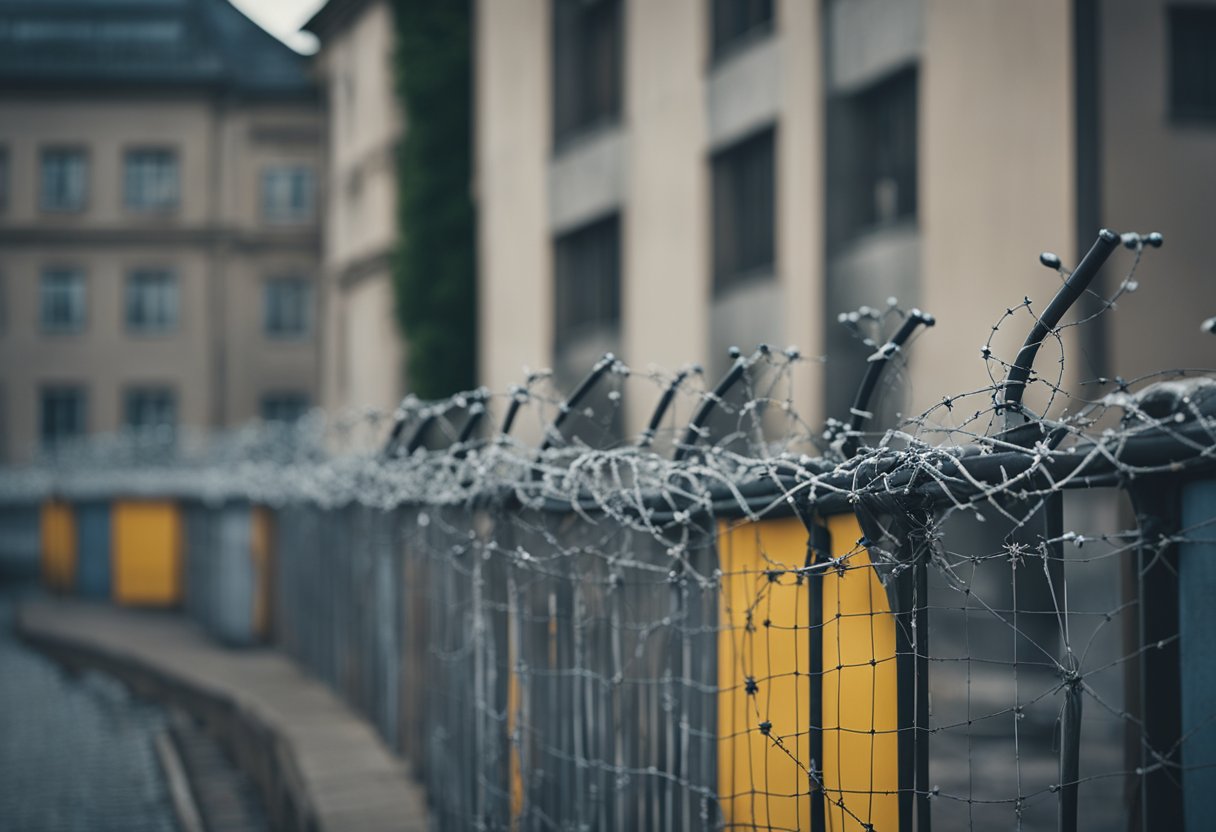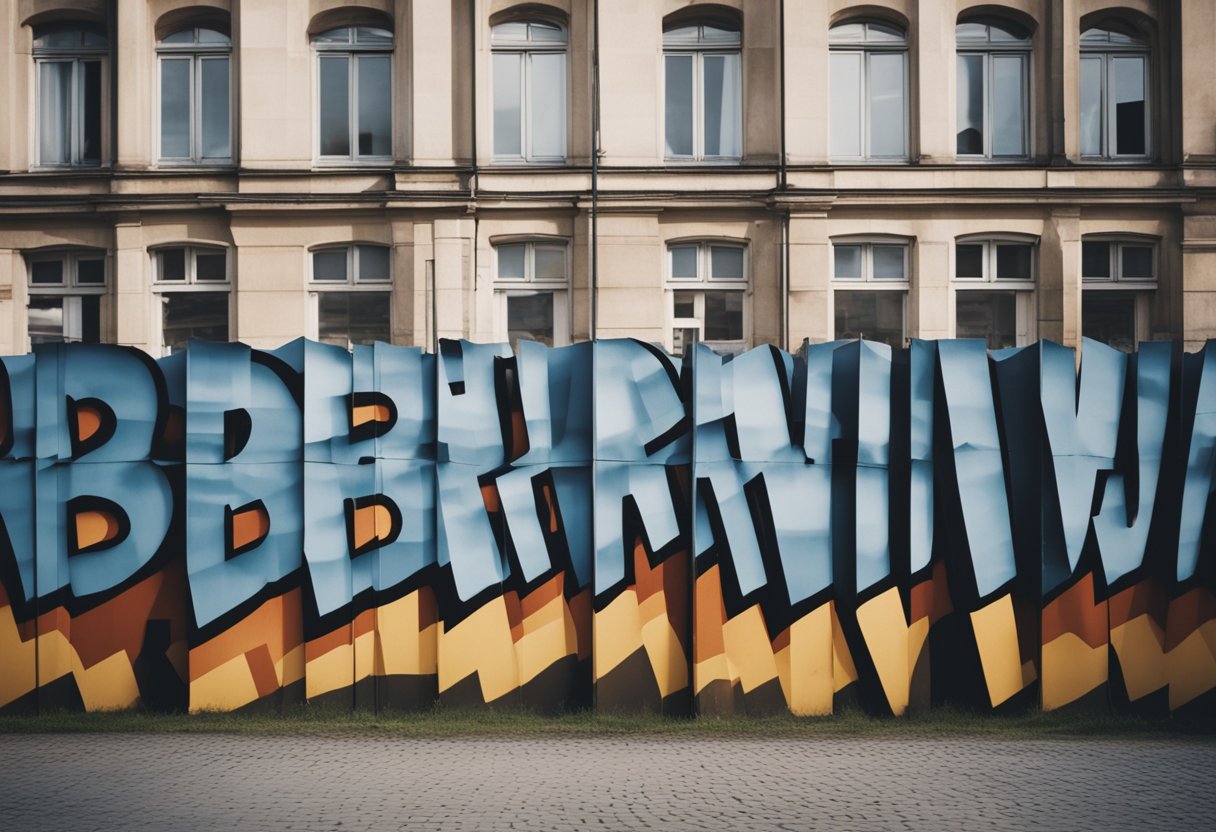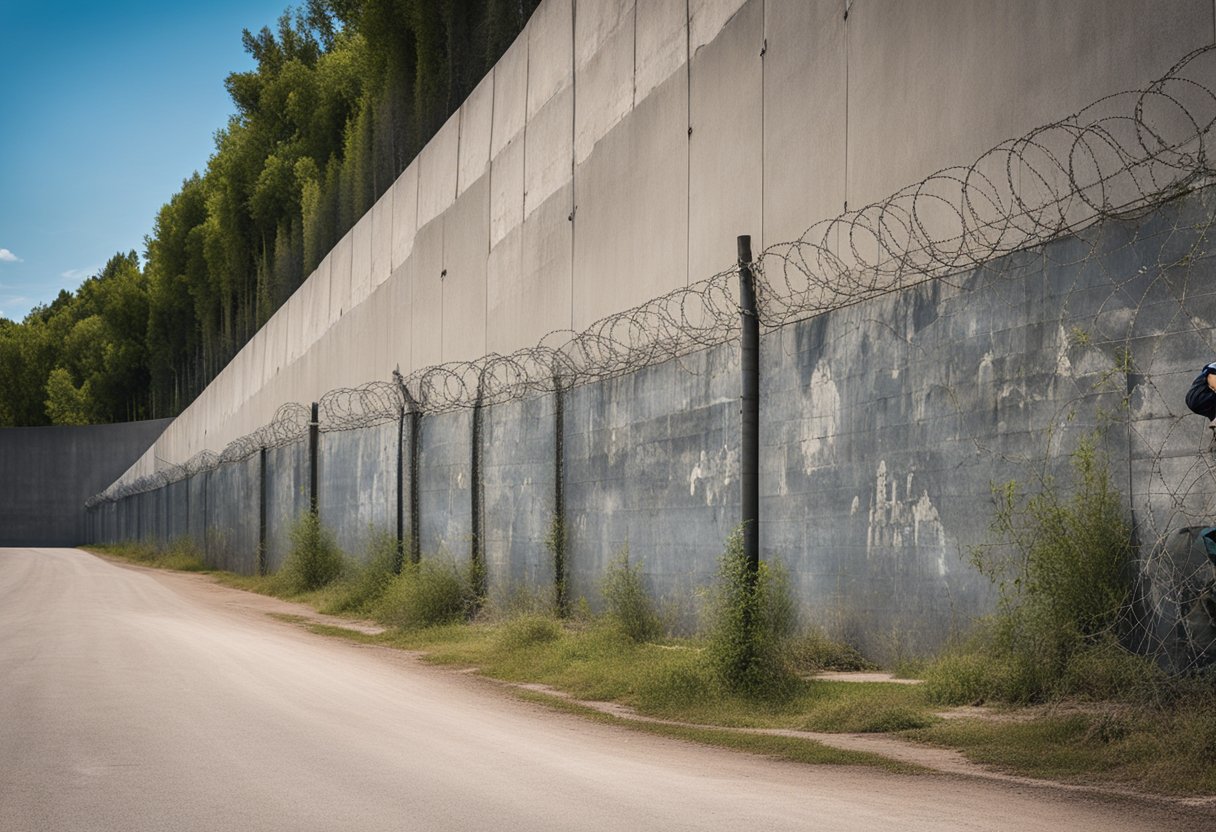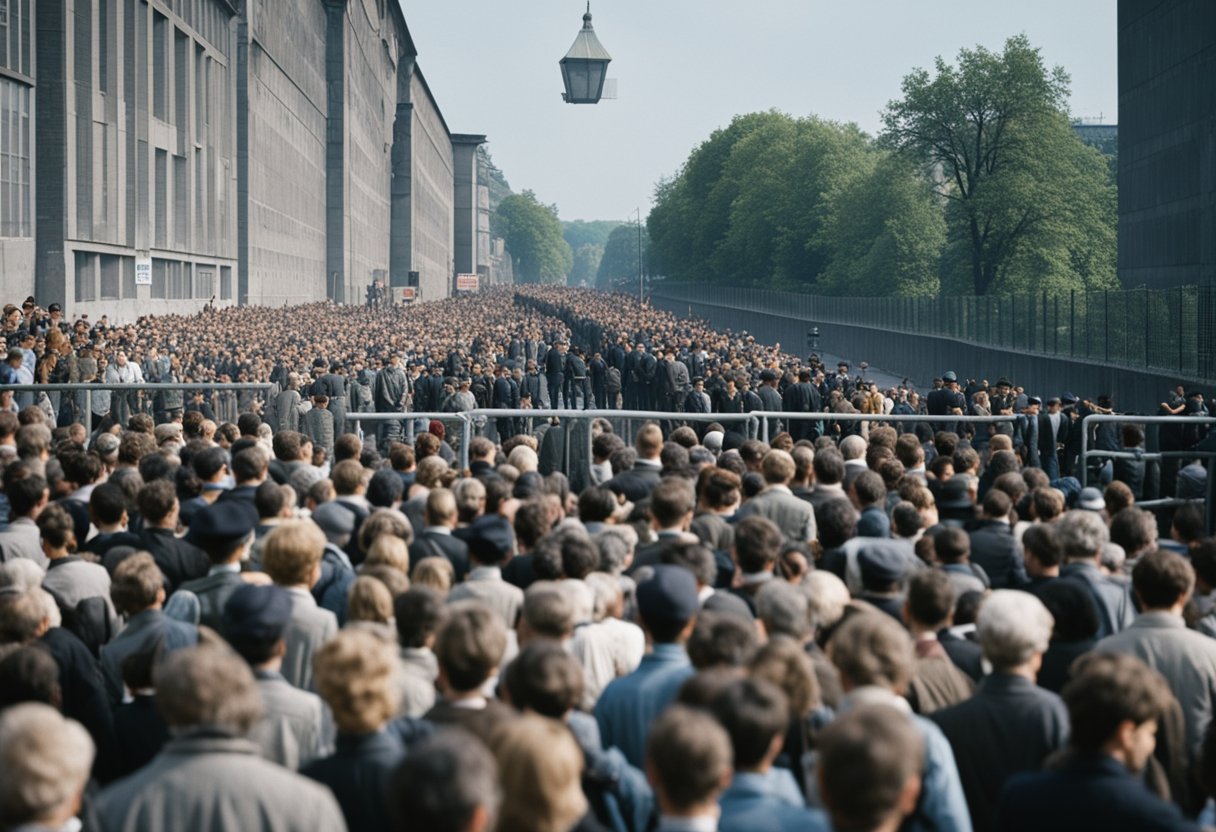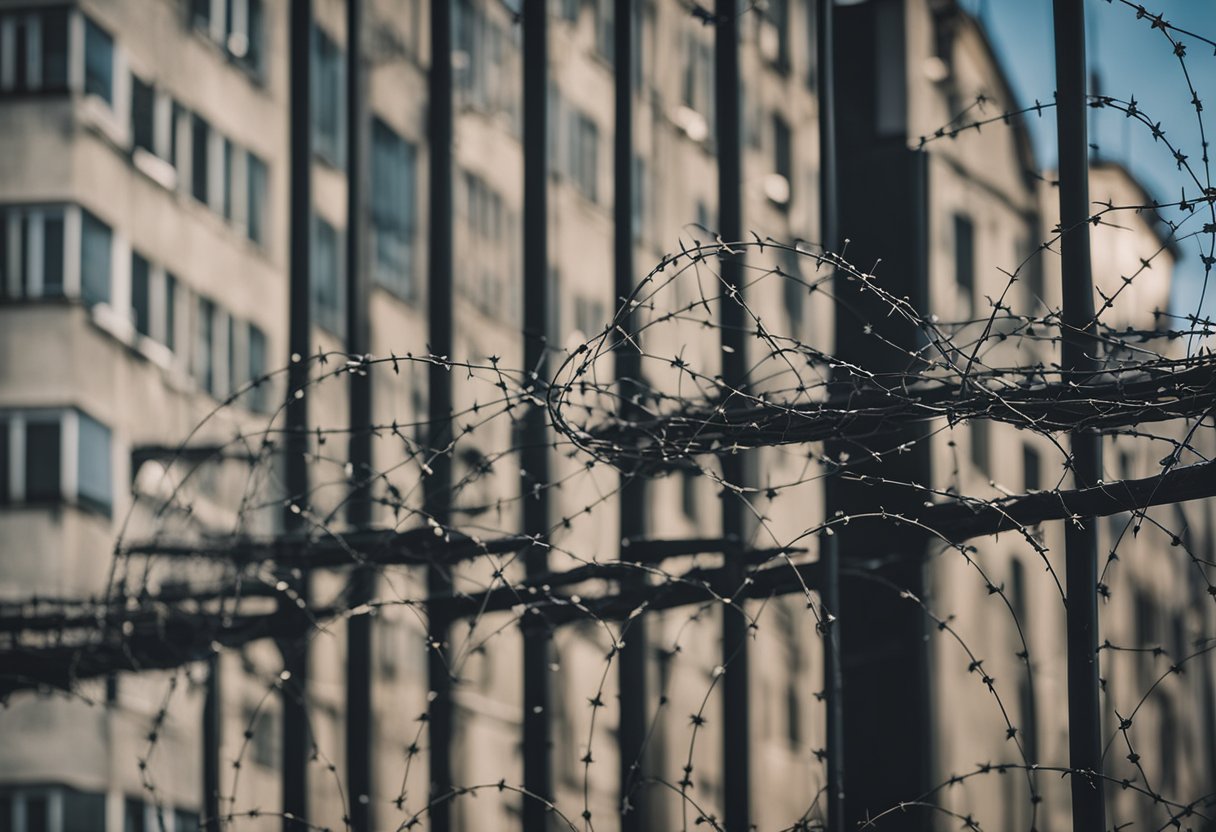The Berlin Wall stood as a physical manifestation of the ideological divide that gripped Germany post-World War II.
Erected in 1961, Berlin Wall divide Germany. It was the culmination of tensions between the Soviet-backed East German government and the Western Allies that controlled West Berlin.
This concrete barrier sliced through the city of Berlin, but its implications resonated across Germany and the entire world.
Its construction aimed to stem the tide of defections from East to West Germany, highlighting the contrasting economic and political systems that had developed in the two Germanys.
Initially, the wall was just a barb-wired fence which later evolved into a 12-foot-high and 4-foot-wide concrete structure, fortified with watchtowers and anti-vehicle trenches.
It effectively sealed off West Berlin, preventing East Germans from fleeing to the West and seeking refuge from the socialist regime.
Interestingly, the entire length of the wall did not encompass the entirety of East and West Germany, but rather encircled West Berlin, making it an island of Western governance amidst the Eastern Bloc.
While the Berlin Wall was initially claimed to be a protective measure against Western fascists, it primarily served to prevent East German citizens from escaping to West Berlin.
Efforts to leave East Germany were met with severe consequences, and many risked their lives to cross the border. Various methods were devised to escape, from digging tunnels to flying in hot air balloons.
The fall of the wall in 1989 was precipitated by a series of political changes and an inadvertent announcement by an East German official, allowing people to cross freely, which ultimately led to the wall being physically broken down by citizens on both sides.
Historical Context- Berlin Wall divide Germany
The division of Berlin by the Berlin Wall is a pivotal moment rooted in the aftermath of World War II and escalating Cold War tensions, deeply affecting German lives and international relations.
Aftermath of World War II
In 1945, following the end of World War II, Germany was left in ruins and occupied by the Allied Powers: the United States, the Soviet Union, the United Kingdom, and France. The country was divided into four occupation zones, each controlled by an ally.
Cold War Tensions
The Yalta and Potsdam conferences had set the stage for post-war governance, but ideological differences between the Allies soon fostered the Cold War.
This mistrust led to the division of Germany into the Federal Republic of Germany (West Germany) and the German Democratic Republic (East Germany).
Formation of the Berlin Wall
Amidst increasing defections and a porous border, East Germany erected the Berlin Wall in 1961, ostensibly as an “Anti-Fascist Protection Rampart”.
This wall effectively sealed off West Berlin from the Soviet-occupied East Berlin and the rest of East Germany.
Life in Divided Germany
The wall divided families and halted the mass exodus of professionals and skilled workers fleeing East Germany.
It became a symbol of oppression, with harsh restrictions on travel and escape attempts that were often deadly.
International Dynamics
Berlin, as a city divided within a divided nation, became a focal point for the Cold War, illustrating the stark contrast between the communist Soviet Bloc and the democratic West.
Major international incidents, including standoffs at Checkpoint Charlie and the Brandenburg Gate, unfolded against the backdrop of the Iron Curtain.
Economic Developments
West Germany experienced the “Economic Miracle” with help from the Marshall Plan and the introduction of the Deutsche Mark, while the East German economy lagged, burdened by communism’s inefficiencies and the drain of resources due to citizens fleeing to the West.
Public Sentiment and Cultural Impact
Public sentiment in East Germany ranged from resignation to active opposition, ultimately culminating in mass demonstrations.
The fall of the Berlin Wall in 1989 — precipitated by a miscommunication by East German official Günter Schabowski — was met with joyous celebration and signaled the beginning of the end of the division of not only Germany but also the Cold War itself.
The Berlin Wall Structure and Its Implications
The Berlin Wall was a formidable barrier that not only physically divided Berlin into East and West but also stood as a stark symbol of the ideological divide cutting through Germany and the Cold War world.
Physical Characteristics of the Wall
The Berlin Wall, constructed in 1961, was a concrete wall that stretched approximately 155 kilometers, encircling West Berlin to prevent East Germans from defecting to the West.
It evolved from a basic wire fence to a complex system of concrete block walls, complete with a smooth pipe at the top to hinder climbers.
Notably, the “fourth-generation” wall, constructed from 1975 to 1980, was made up of 45,000 separate sections of reinforced concrete, each 3.6 meters high and 1.2 meters wide.
Border Fortifications and Control
Surrounding the Berlin Wall itself was a heavily fortified border known as the death strip, a sandy tract that offered no cover and was riddled with armed watchtowers, floodlights, and patrolling East German border guards.
The inner German border featured similar fortifications, extending the division to include an expansive “no man’s land” of fences, ditches, and patrols.
This network of barriers was punctuated by iconic border crossings like Checkpoint Charlie, Helmstedt, Dreilinden, and Friedrichstrasse, where tightly controlled and restricted travel was possible.
Impact on Mobility and Migration
The Berlin Wall had an immense impact on mobility and migration, effectively halting most unauthorized movement between East and West Germany.
Attempts to escape the Eastern bloc were fraught with peril, and numerous refugees lost their lives trying to traverse the death strip.
Despite this, some managed to flee through daring plans, involving tunnels, forged documents, and even hot air balloons.
The migration repercussions were profound, as the wall not just separated families and friends but also stemmed the tide of defections that had plagued the East German state prior to its construction.
Events Leading to the Fall of the Wall
The Berlin Wall’s demise resulted from a convergence of political shifts and persistent public outcry. The following subsections detail the crucial events that culminated in the Wall’s opening and the eventual end of Germany’s division.
Political Changes and Pressures
The 1980s were marked by significant political changes within the Communist regimes of Central and Eastern Europe.
Mikhail Gorbachev’s introduction of policies like glasnost (openness) and perestroika (restructuring) encouraged more openness and economic reform within the Soviet Union, which influenced the satellite states.
Hungary began dismantling its border fence with Austria, creating a loophole for East Germans who wanted to escape to the West.
This put enormous pressure on the GDR (German Democratic Republic or East Germany) government, signaling cracks in the once-impenetrable Iron Curtain.
Nov 9, 1989 – The Wall Opens
A pivotal moment came on November 9, 1989, when Günter Schabowski, an East German official, mistakenly announced immediate visa-free travel for East Germans.
This led to masses of East Berliners flocking to checkpoints like Checkpoint Charlie, demanding border guards to open the gates.
The guards, overwhelmed and without clear orders, eventually yielded, allowing people to cross freely. That night, the Berlin Wall, the most potent symbol of the divide, was effectively breached.
Public Actions and Demonstrations
Prior to the Wall’s opening, large-scale public demonstrations were instrumental in applying pressure on the East German government.
Notably, half a million people gathered in East Berlin in a mass protest just days before the Wall’s fall. This unprecedented outpouring of public dissent significantly weakened the resolve of the leadership to maintain the division of Berlin.
Over the weeks and months preceding November 9, 1989, the mass demonstrations and the clamor for freedom and reform became impossible for the East German authorities to ignore, thereby contributing to the decision to open the Wall.
Consequences of the Berlin Wall
The Berlin Wall not only physically divided Berlin into East and West but also came to symbolize the ideological divide between communism and democracy during the Cold War.
Its presence had profound effects that led to a dramatic and significant period in German history.
Path to German Reunification
The Berlin Wall stood as a concrete manifestation of the divide between the socialist regime of East Germany and the democratic West.
It hindered free movement and familial connections, which ultimately fueled a desire for reunification. The Fall of the Berlin Wall in 1989 was a pivotal moment that set into motion the process of reunifying Germany.
The Brandenburg Gate, once isolated by the Wall, became a symbol of the country’s forthcoming unity.
Legacy and Remembrance
The Berlin Wall’s legacy is multifaceted, representing a significant period of political tension and the suppression of personal and political freedoms.
Today, parts of the Wall and Checkpoint Charlie serve as reminders of Berlin’s history and the resilience of its citizens.
Memorials and museums in places like Bernauer Strasse provide educational resources and ensure the memory of this period is preserved for future generations.
Human Cost and Memorials
The human cost of the Berlin Wall was significant; over 100 people died trying to escape from East to West Berlin.
These were often desperate attempts that took place in the heavily guarded “death strip.” Memorials scattered throughout Berlin, such as the crosses near the Reichstag, honor those who lost their lives.
These sites encourage reflection on the personal sacrifices made in pursuit of freedom and highlight the Wall’s ultimate failure to suppress the human spirit’s quest for liberty.
Impact on Global Politics
The erection of the Berlin Wall in 1961 and its subsequent fall in 1989 had significant implications for global politics, influencing the dynamics of superpower relations and the political landscape of the Eastern Bloc countries, which culminated in the reshaping of international stances post-Wall.
Superpower Relations
The Berlin Wall became a formidable physical manifestation of the Cold War, delineating the battle lines between the United States and the Soviet Union.
During its existence, it was not just the supremacy of military might that was contested but also ideological dominance between capitalism and communism.
The Big Three—the United States, Britain, and France—alongside their Soviet counterparts, frequently met during events like the Yalta and Potsdam conferences to negotiate terms that inevitably contributed to Germany’s division.
Influence in the Eastern Bloc
Following World War II, the Soviet Bloc, comprising countries like Poland, Bulgaria, and Albania, looked to the USSR for guidance since they were part of its sphere of influence.
The Berlin Wall symbolized the Iron Curtain, and its presence was a clear signal to these nations of the Soviet commitment to maintain this buffer zone against western ideologies.
The manner in which East Germany enforced its border policy was observed closely by neighboring countries within the Soviet ambit.
Perspectives on the Berlin Wall
The Berlin Wall remains one of the most powerful symbols of the Cold War era, encapsulating the ideological contest between communism and democracy.
Within its shadows, a divided Berlin became the epicenter of tensions between East and West.
East vs. West Ideological Divide
The construction of the Berlin Wall solidified the ideological divide between communist East Germany and democratic West Germany.
It not only physically separated families and communities but also represented the differing political ideologies that dominated the Cold War landscape.
To the West, it was a barrier against communist expansion; to the East, a defensive measure to protect its socialist state.
Symbolism and the Iron Curtain
The Berlin Wall was more than a physical boundary; it was a symbol of the Iron Curtain that separated the Soviet-controlled communist bloc and the Western democracies.
Iconic checkpoints like Checkpoint Charlie and landmarks such as the Brandenburg Gate became focal points of this division, with the latter trapped in a no-man’s land until the Wall fell.
The Wall served as a forbidding emblem of repression to many, especially to those in West Berlin.
Reflections in Modern Germany
The legacy of the Berlin Wall persists in modern Germany, shaping its collective memory and continuing to influence perceptions of freedom and oppression.
The remnants of the Wall, along with other sites in Berlin, serve as somber reminders of past divides and the triumph of German reunification.
The decision by East Germany to open the Berlin Wall in 1989 was pivotal, leading to joyous scenes of East and West Germans coming together, paving the way for the eventual reunification of Germany.
Annex: Notable Elements
This section focuses on the influential people and crucial locations that played pivotal roles in the history and function of the Berlin Wall.
Key Figures and Leadership
Walter Ulbricht, then leader of East Germany, oversaw the initial construction of the Berlin Wall in 1961, which led to the physical division of Berlin.
Later, Mikhail Gorbachev’s policies of glasnost and perestroika were significant in creating an environment that led to the Wall’s eventual fall.
John F. Kennedy and Winston Churchill were key Western leaders whose policies and speeches, such as Kennedy’s famous “Ich bin ein Berliner,” reflected the Western response to the Wall.
On the evening of November 9, 1989, a seemingly unintentional announcement by East German official Günter Schabowski regarding travel regulations led to the fall of the Berlin Wall as crowds surged to the checkpoints.
Notable Locations and Crossings
The Berlin Wall, while it stood, featured several key crossings. Checkpoint Charlie became one of the most famous, serving as the main gateway for foreigners and diplomats between East and West Berlin.
Bernauer Strasse garnered attention as people attempted to escape from windows of apartments that bordered the Wall.
Helmstedt and Dreilinden were major Autobahn crossing points used for transit between West Berlin and West Germany.
The Brandenburg Gate, which lay just inside East Berlin, was closed off by the Wall but later became the site of massive celebrations when Germany was reunified.
Friedrichstrasse station was also a major crossing point and housed a well-known checkpoint. These locations became poignant symbols of the division of not just a city and a country but also of a world during the Cold War.
Frequently Asked Questions
This section addresses common inquiries regarding the motivations, political context, and consequences of the erection and demolition of the Berlin Wall, a significant historical barrier that divided the German capital.
What were the motivations behind erecting the Berlin Wall?
The primary motivation for erecting the Berlin Wall was to prevent the mass emigration and defection of East Germans to the West. East German authorities aimed to halt the brain drain of skilled workers and intellectuals that was destabilizing the country’s economy.
How did the division of Berlin into four zones lead to the construction of the Wall?
Post-World War II, Berlin was divided into four zones controlled by the Allied powers. Tensions between the Soviet Union and Western Allies led to escalating confrontations. The erection of the Berlin Wall solidified the division, creating a concrete manifestation of the Iron Curtain that separated the communist East from the democratic West.
What were the political circumstances that led to the fall of the Berlin Wall?
The fall of the Berlin Wall was precipitated by mounting political pressure, a surge of civil unrest in East Germany, and a series of liberal reforms in the Soviet Union. These factors combined to create an environment where the East German government could no longer maintain the Wall as a barrier.
In what ways did the Berlin Wall impact Germany during its existence?
During its existence, the Berlin Wall was a physical and ideological division that split families, hindered freedom of movement, and became a symbol of the broader separation between Eastern and Western blocs. It had profound social, economic, and psychological impacts on German society.
Can the symbolism of the Berlin Wall’s fall be elaborated upon?
The fall of the Berlin Wall is symbolically tied to the end of the Cold War, representing a victory for freedom and democracy. It marked the beginning of Germany’s reunification and the collapse of communist regimes across Eastern Europe.
When exactly did the dismantling of the Berlin Wall take place and what triggered it?
The dismantling of the Berlin Wall officially began on November 9, 1989, after the East German government announced that all GDR citizens could visit West Germany and West Berlin. Crowds of East and West Germans then gathered to celebrate and began physically dismantling the Wall themselves.
